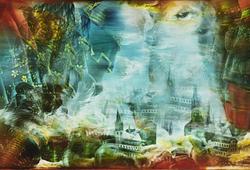A late 17th century parcel-gilt silver filigree casket with painted enamel medallion and gemstones, Nothern Europe.
Rectangular casket standing on four ball feet, gilded hinges on the short sides, a hinged lid with a smaller drawer/casket above, also with a hinged lid. Decor of green enamel at the top in the form of acanthus leaves, the lid is also adorned with six rubies and one carnelian. Richly decorated lock plate. In the corners, small gilded sculptures depicting Jupiter with a thunderbolt standing on an eagle. Inside the larger lid, there is an enamel medallion with Spes holding an anchor, i.e., the personification of the theological virtue of 'Hope', and on the bottom plate, there is an emblematic motif with a putto with a trumpet surrounded by dogs chasing a deer after Vaenius Emblemata from 1618. Height 13 cm, length 16 cm, width 10.5 cm. Weight approx. 655 g.
The original wood box covered with embossed leather and with velvet lining is included.
Alkuperä - Provenienssi
Baron Carl Gustaf Lagerfelt (1724-1797) His estate inventory includes under Silver, Gilded: "1 Filigree Box with gilded Pictures and set stones of a Carnelian and several Rubies unweighed, 50 5/8 [lod]".
Later his great-grandson,
Erik Storckenfeldt (1847-1902). His estate inventory: "1 antique box [Silver]".
Thereafter inherited to the current owner.
Muut tiedot
Unique filigree casket from the 17th century – an art historical masterpiece with an international touch
The auction's outstanding casket is a rare and complex work of art that carries a cultural and geographical heritage across several continents. What few people may not think about today is how international the Baroque was, the style spread via colonial countries when objects were specially commissioned in other parts of the world and sent to Europe.
The casket, which bears traces of both oriental and European craftsmanship – is made of silver and from the late 17th century, made in the ancient and exquisite filigree technique. The name of the technique derives from the Latin filum (thread) and granum (grain) and is characterized by intricate patterns in thin metal wire, often joined with small balls and decorative solders.
The panels executed in filigree technique may well have originated in Indonesia – perhaps Java, Sumatra, Jakarta or Goa in India – areas known for their exquisite filigree work during the period, often under Indo-Portuguese or Dutch colonial influence. At the same time, the assembly and certain stylistic features strongly indicate European, probably Swedish, manufacture: the lock plate, the handles and not least the European base plate with its inward-facing motif reminiscent of lids on tankards of the time. The enamel miniature, depicting Spes – the virtuous figure of hope – with an anchor is of a standardized type found on several objects from the time (see the silver ornament at the Nationalmuseum in Sweden, no. NMK CXV 1505).
Comparisons with preserved examples in the collections of, for example, Skokloster castle and the Nationalmuseum, as well as similarities with works by goldsmiths such as Rudolf Wittkopf, Johan Friedrich and Johann Heinrich Straub and Johan Ståhle, strengthen the hypothesis that the casket was assembled in Sweden. Wittkopf's two beakers with lids for King Charles XII of Sweden, now in the collections of the Nationalmuseum, bear several similarities to this casket. The Straub brothers, originally from Nuremberg – the European centre for filigree forging and assembly at the time – were active in Karlstad and Gothenburg in Sweden, and are known for having brought the technique here. It is precisely in this tension between international influence and local anchoring that this casket acquires its unique character.
The casket is adorned with six sparkling rubies, a carnelian, and characteristic diamond-shaped soldering – a style often linked to Swedish tradition. The applied rosettes, the cast figures and the border decoration on the edge of the lid are reminiscent of other Swedish works from the period. The motif of Jupiter with a thunderbolt in his hand carried by an eagle, a common feature in 17th-century German silver, adds further layers of symbolism and continental influences.
This casket lacks marks, which is common for objects of this type. But that is precisely what makes it an exciting and sought-after object – an object to explore, discuss and marvel at.
A magnificent example of 17th century global craftsmanship – where Eastern detail meets the robust elegance of Swedish silver. The box is in unusually well-preserved condition as it has been stored in its original case made of pine and covered with embossed leather.
Bukowskis is very grateful to Susann Silfverstolpe for her valuable comments in connection with the cataloguing of this object.
Text from Emblemata 1608 to the engraving:
The chasing goeth before the taking.
Before the deer bee caught it first must hunted bee,
The Ladie eke pursu’d before shee bee obtaynd,
Payn makes the greater woorth of oughts thats thereby gaynd,
For nothing easly goo wee do esteemed see.


















































































































